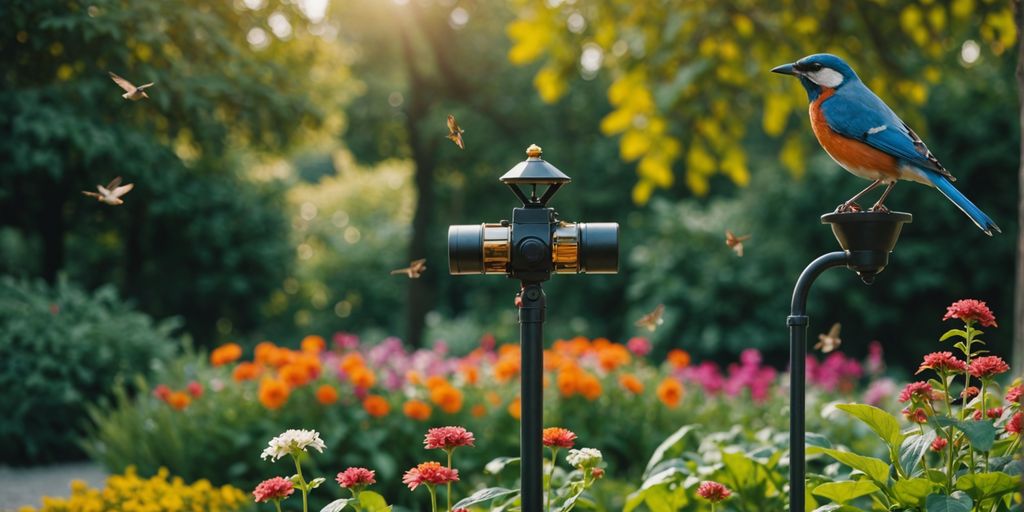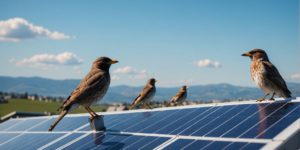Birds, while beautiful and beneficial to the environment, can sometimes become a nuisance, especially when they invade spaces where they aren’t welcome. Natural bird deterrents offer humane and eco-friendly solutions to keep birds at bay without causing them harm. In this article, we will explore various natural methods to deter birds, ranging from using predatory birds and reflective objects to employing sound and scent repellents.
Key Takeaways
- Natural bird deterrents provide a humane and eco-friendly way to manage bird-related issues.
- Using predatory birds can be an effective method to naturally scare away nuisance birds.
- Reflective objects and sound deterrents can be useful but may require regular adjustments for sustained effectiveness.
- Scent repellents and physical barriers offer additional layers of protection against bird invasions.
- Combining multiple deterrent methods often yields the best results in keeping birds away.
Understanding Natural Bird Deterrents
Natural bird deterrents are essential for maintaining the balance between human activities and wildlife. These methods are eco-friendly and often more sustainable compared to chemical or mechanical alternatives. They help in mitigating bird-related issues without causing harm to the birds or the environment.
Using Predatory Birds as Deterrents
Types of Predatory Birds
Predatory birds such as hawks, falcons, and owls are highly effective in deterring nuisance birds. These natural predators instill fear in smaller birds, making them avoid areas where these predators are present. Hawks and falcons are particularly effective due to their hunting prowess and territorial nature. Owls, being nocturnal, can provide round-the-clock deterrence when combined with diurnal predators.
How Predatory Birds Deter Other Birds
The presence of predatory birds taps into the instinctual fear of smaller birds. When these predators are around, nuisance birds are less likely to nest or linger in the area. This method is not only natural but also sustainable, as it leverages the existing ecosystem. For those wondering how to stop pigeons nesting, introducing predatory birds can be a game-changer.
Setting Up a Predatory Bird Program
- Identify the Target Area: Determine where the bird problem is most severe, such as near solar panels or gardens.
- Choose the Right Predators: Select predatory birds that are native to your region and effective against the specific nuisance birds you’re dealing with.
- Partner with Experts: Work with a professional pigeon removal service or a falconry expert to ensure the program is set up correctly.
- Monitor and Adjust: Regularly monitor the effectiveness of the program and make adjustments as needed. This might include rotating the predatory birds or combining this method with other deterrents.
Using predatory birds is a natural and effective way to deter nuisance birds. By leveraging the fear these predators instill, you can protect areas like solar panels and gardens from bird-related damage.
Combining this method with other deterrents, such as reflective objects or scent repellents, can enhance its effectiveness and provide a comprehensive solution to bird problems.
Implementing Reflective Objects
Reflective objects are a popular and humane method to deter birds from certain areas. These objects work by creating visual disturbances that birds find unsettling, thus encouraging them to avoid the area. Reflective objects are especially effective in open spaces where they can catch and reflect sunlight. This method is not only cost-effective but also easy to implement and maintain, making it a preferred choice for many property owners.
Types of Reflective Objects
There are various types of reflective objects that can be used to deter birds. Some common options include:
- CDs and DVDs: Old CDs and DVDs can be hung from trees or eaves to create a reflective surface that moves with the wind.
- Reflective Tape: This tape can be strung across areas where birds are not wanted. It flutters in the wind and reflects light, creating a visual deterrent.
- Mirrors: Small mirrors can be strategically placed to reflect sunlight into areas where birds are a problem.
- Commercial Reflective Products: These are specifically designed for bird deterrence and are often more durable and effective than DIY options.
Effectiveness of Reflective Objects
Reflective objects are generally effective in deterring birds, but their success can vary based on several factors. The type of bird, the specific environment, and how the reflective objects are placed all play a role in their effectiveness. For instance, reflective tape is often more effective in windy areas where it can move freely. However, it’s important to note that birds can sometimes become accustomed to these objects over time, reducing their effectiveness.
Placement Tips for Maximum Effectiveness
To maximize the effectiveness of reflective objects, consider the following placement tips:
- Height: Place reflective objects at varying heights to cover more area and create a more unpredictable environment for birds.
- Movement: Ensure that the objects can move freely in the wind to create dynamic reflections and flashes of light.
- Coverage: Use multiple reflective objects to cover the entire area where birds are a problem. This will create a more comprehensive deterrent.
- Maintenance: Regularly check and adjust the placement of reflective objects to ensure they remain effective. Over time, birds may become accustomed to static objects, so occasional repositioning can help maintain their deterrent effect.
Reflective objects offer a simple yet effective solution for deterring birds without causing them harm. By strategically placing these objects, you can create an environment that birds find unwelcoming, thus protecting your property from bird-related issues.
Utilizing Scent Repellents

Scent repellents are a natural and effective way to deter birds from unwanted areas. These repellents often use strong scents that birds find unpleasant, such as essential oils or spices. Using scent repellents can be a humane and eco-friendly method to keep birds at bay without causing them harm. However, it’s important to apply these scents consistently to maintain their effectiveness.
Installing Physical Barriers
Physical barriers are an effective way to deter birds from accessing certain areas. These barriers can be particularly useful in protecting solar panels, gardens, and other vulnerable spots from bird damage. By creating a physical obstruction, you can prevent birds from nesting or perching in unwanted areas. Here are some common types of physical barriers and tips for their installation and maintenance.
Employing Sound Deterrents
Sound deterrents are an effective way to keep birds away from specific areas. These methods leverage the natural aversion birds have to certain noises, creating an environment that is uncomfortable for them to inhabit. Goldshot Exterminating offers various sound deterrent solutions that can be tailored to your specific needs.
Using Visual Scare Tactics
Visual scare tactics are a popular and effective method for deterring birds from specific areas. These tactics leverage birds’ natural instincts to avoid potential threats, making them a humane and non-lethal option for bird control. The key to success with visual scare tactics is variety and movement, which prevent birds from becoming accustomed to the deterrents.
Creating an Unwelcoming Environment
Creating an environment that is unappealing to birds is a crucial step in natural bird deterrence. By making your property less attractive, you can significantly reduce bird-related issues.
Combining Multiple Deterrent Methods
When it comes to bird deterrents, using a combination of methods can often yield the best results. Combining different strategies can address various bird-related issues more effectively than relying on a single approach. This section explores the benefits and effective combinations of multiple deterrent methods, along with real-world case studies to illustrate their success.
Legal and Ethical Considerations
When implementing bird deterrents, it’s crucial to be aware of the legal and ethical considerations involved. Understanding these aspects ensures that your methods are both effective and humane.
Monitoring and Adjusting Deterrent Strategies
Regular Monitoring Tips
Consistent monitoring is essential to ensure the effectiveness of your bird deterrent strategies. Regular inspections can help identify any issues early on, such as damaged deterrents or new bird activity. Use a checklist to keep track of the areas you need to inspect and the specific deterrents in place.
Adjusting Strategies Based on Effectiveness
If you notice that certain deterrents are not working as expected, it may be time to adjust your approach. This could involve changing the type of deterrent, altering its placement, or combining it with other methods. Flexibility is key to maintaining an effective bird deterrent program.
Long-Term Maintenance
Long-term maintenance involves not only regular inspections but also the upkeep of the deterrents themselves. For example, if you are using galvanized steel mesh for solar panels, ensure it remains intact and free from rust. Regular cleaning and repairs will prolong the life of your deterrents and keep them effective.
Maintaining a proactive approach to bird deterrence can save you time and resources in the long run. By staying vigilant and adaptable, you can effectively manage bird-related issues and protect your property.
Effective monitoring and adjusting of deterrent strategies are crucial for maintaining the efficiency and longevity of your solar energy systems. Our comprehensive services ensure your system functions optimally, providing you with peace of mind and maximum energy production. Visit our website to learn more about our solar services and accessories.
Conclusion
In conclusion, natural bird deterrents offer a humane and effective way to protect your property from bird-related damage. By utilizing methods such as netting, bird spikes, and scent repellents, you can create an environment that discourages birds from nesting or perching without causing them harm. Additionally, incorporating visual deterrents like shiny objects or predator decoys can enhance the effectiveness of these measures. It is important to regularly maintain and adjust these deterrents to ensure their continued success. By combining multiple strategies and staying vigilant, you can safeguard your solar panels, gardens, and other vulnerable areas from the potential damage caused by birds.
Frequently Asked Questions
What are natural bird deterrents?
Natural bird deterrents are methods used to prevent birds from landing, nesting, or causing damage without harming them. These include using predatory birds, reflective objects, scent repellents, physical barriers, sound deterrents, and visual scare tactics.
Why should I use natural bird deterrents?
Natural bird deterrents are eco-friendly and humane methods to keep birds away. They help prevent damage to property, crops, and solar panels while avoiding harm to the birds and the environment.
How do predatory birds deter other birds?
Predatory birds such as falcons, hawks, and owls naturally scare other birds away due to their presence. Smaller birds perceive them as threats and avoid areas where predatory birds are present.
What types of reflective objects can be used to deter birds?
Common reflective objects used to deter birds include old CDs, aluminum foil, reflective tape, and mirrors. These objects reflect light, which confuses and scares birds away.
How effective are scent repellents in deterring birds?
Scent repellents can be quite effective as birds have a strong sense of smell. Common scent repellents include essential oils like peppermint, garlic, and chili powder. These scents are unpleasant to birds and can keep them away from treated areas.
What are some examples of physical barriers for bird deterrence?
Physical barriers include bird netting, spikes, and mesh. These barriers prevent birds from accessing certain areas, such as rooftops, gardens, and solar panels, effectively keeping them away.
Can sound deterrents harm birds?
When used correctly, sound deterrents do not harm birds. They emit sounds that are irritating or alarming to birds, causing them to avoid the area. It’s important to use these devices responsibly to avoid unnecessary stress to the birds.
Is it legal to use bird deterrents?
Yes, it is legal to use bird deterrents, but it’s important to follow local wildlife protection laws. In many regions, certain bird species are protected, and it is illegal to harm them or disturb their nests. Always use humane methods and check local regulations before implementing bird deterrents.



